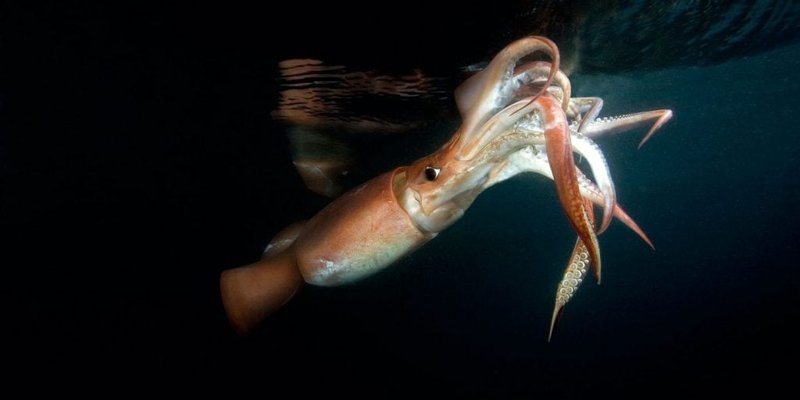
Understanding the Humboldt Squid’s Diet
When it comes to their diet, Humboldt squids are carnivorous, meaning they mainly eat meat. These squids have a diverse menu that includes fish, shrimp, and other cephalopods. Think of them as the ocean’s version of a buffet enthusiast, sampling various delicacies from their underwater surroundings.
One reason for their varied diet is their size. Humboldt squids can grow to about 6 feet long and weigh up to 100 pounds. This size allows them to target larger prey than many other squid species. They are known to have an appetite that’s as big as they are, often consuming up to 40% of their body weight in a single meal. Imagine eating a huge pizza all by yourself—that’s how these squids roll!
Hunting Techniques of Humboldt Squids
You might be wondering how the Humboldt squid catches its prey. These squids are not just mindless eaters; they have developed some fascinating hunting techniques. They often hunt in groups called “squadrons,” which can make them incredibly efficient hunters. By working together, they can overwhelm schools of fish and other prey.
Their primary weapon? Speed and agility. Humboldt squids can swim up to 15 miles per hour. This speed helps them close the gap quickly before their prey even knows what hit them. They also have specialized arms lined with suckers that allow them to grasp onto slippery fish. It’s like having an extra set of hands when it comes to securing dinner!
The Role of Bioluminescence
Another interesting aspect of their hunting strategy is the use of bioluminescence. Humboldt squids can produce light, which they may use to confuse their prey or communicate with each other in dark waters. Imagine being in a dim room and having someone suddenly turn on a bright flashlight—it’s disorienting! This ability gives them an edge, making it easier to catch unsuspecting fish.
Feeding Habits and Social Behavior
Feeding behavior in Humboldt squids is also tied to their social structure. Squids are known to be social creatures, especially when hunting. They often use different communication signals, such as color changes and body posture, to coordinate their efforts. When they spot a school of fish, they can communicate their intentions to each other quickly.
In addition, Humboldt squids engage in a behavior known as “hunting in packs.” This strategy not only increases efficiency but also allows them to share information about the best hunting grounds. When one squid finds a good source of food, the others quickly follow suit. It’s a bit like having a group of friends who all tell each other about the best pizza place in town!
Impact of the Environment on Feeding
The diet of Humboldt squids can fluctuate depending on environmental conditions. Changes in water temperature, salinity, and food availability can all impact what these squids eat. For instance, if a particular species of fish migrates due to temperature changes, the squids will adapt by targeting whatever is available around them.
Interestingly, Humboldt squids are often associated with upwelling zones. These areas, where nutrient-rich waters rise to the surface, create ideal conditions for supporting marine life. When conditions are right, you can find a dense population of these squids feasting on the abundance of prey that thrives in such rich waters.
Seasonal Variations
Another factor is seasonal changes. During certain times of the year, the availability of prey can increase significantly. This is particularly true during breeding seasons when schools of fish gather for reproduction. As a result, Humboldt squids may increase their feeding activity during these times, taking full advantage of the plentiful food sources.
Challenges and Threats to Their Diet
Despite their formidable hunting skills, Humboldt squids face challenges that can affect their diet. Overfishing is a significant threat, as many of their prey species are targeted by commercial fisheries. When fish populations decline, squids must adapt to eat different types of prey, which can be a challenge if they’re accustomed to hunting specific species.
Another concern is climate change, which can impact marine ecosystems. Warmer water temperatures can alter the distribution of prey species, forcing Humboldt squids to travel greater distances to find food. It’s a tough world out there for these fascinating creatures, and their survival depends on being adaptable.
The diet and feeding habits of the Humboldt squid paint a vivid picture of life in the ocean. As powerful predators, they play an essential role in maintaining the balance of marine ecosystems. Their ability to adapt to changing environments, hunt in groups, and exploit various food sources showcases their resilience and intelligence.
By understanding these squids’ diets, we can appreciate the complexities of ocean life and the interconnections among species. So next time you think about the wonders of the sea, remember the Humboldt squid—an incredible creature that reminds us of nature’s endless mysteries. Whether you’re an aspiring marine biologist or just someone curious about ocean life, there’s always more to explore beneath the waves!
